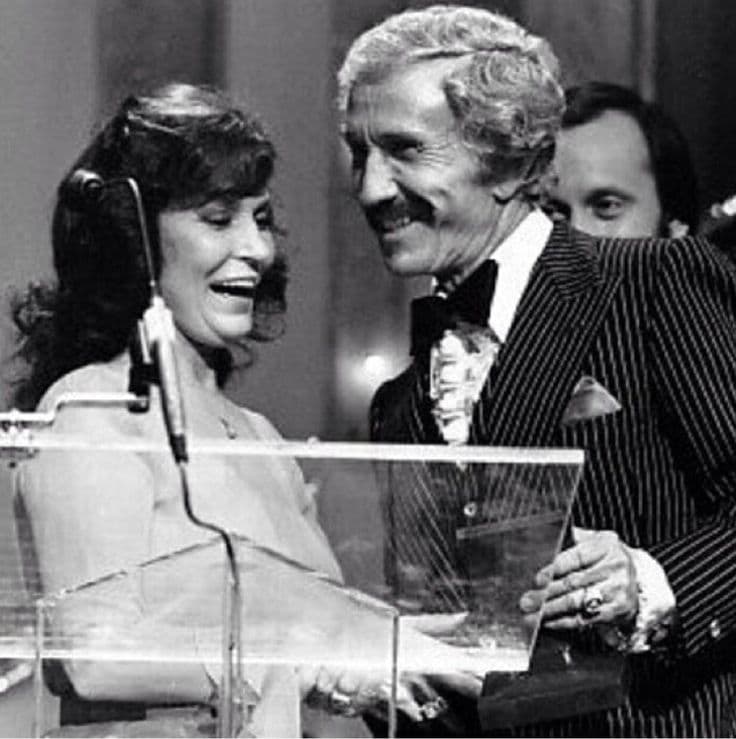
A timeless salute to sorrow where two voices carry the weight of saying goodbye
When Marty Robbins and Loretta Lynn joined forces for “Singing the Blues,” they shaped a delicate conversation between heartache and resolve—a duet more imagined than widely documented, yet rich with retrospective meaning. Robbins’s original version of the song soared to No. 1 on the Billboard Country chart for 13 weeks in late 1956, and peaked at No. 17 on the U.S. pop chart. While a direct commercial chart listing for a Robbins-Lynn duet version remains unverified, live recordings and later reference work suggest that the pairing brought fresh emotional texture to a classic track.
From the first chord, the song embraces both inevitability and defiance. The lyrics begin with simple sentences—“My baby went away…”—and grow into something richer: a statement of loss, yes, but also a refusal to let that loss silence the singer. Robbins’s voice on the original recording is steady yet wounded; the instrumentation is warm, countrified, and unsparing in its sincerity. When Lynn’s voice is imagined alongside his, the track becomes not only the lament of one person, but the reflection of two souls who know too well the ache of absence and the sting of memory.
The story behind the song begins with its writer, Melvin Endsley, who composed “Singing the Blues” in 1954. His simple but effective lines captured the essence of wounded pride and the choice to sing despite it. Robbins took that composition to the studio early in November of 1955 and released it in August of 1956. The recording became a defining moment in Robbins’s career—it announced the emotional range he could bring to country music, beyond the Western ballads for which he was already known.
Adding Loretta Lynn into the equation—even if officially documented only later or in live form—changes the colour of the song. Her voice carries a different kind of weariness and strength: a woman who has loved, lost, and endured. In duet form, the song’s lament becomes a dialogue; the singular “I” becomes “we,” or at least “us.” The pain shared between voices becomes communal rather than solitary. According to archive sources, a performance with both artists exists (for example a recorded live version), affirming that this collaboration had a visceral reality beyond speculation.
Musically, the arrangement underscores the melancholy without surrendering to melodrama. The steel guitar hums quietly, the rhythm section stays steady but unobtrusive, the melody gives space for the lyrics to unfold. In the duet rendition, the back-and-forth of voices suggests tension, but also acceptance—it’s not a song of bitter recrimination, but of recognizing that some things are irretrievable and choosing to sing anyway. For older listeners, this style evokes evenings when radio play was gentle, when albums carried the hush of stories told between generations, when the turn of a record marked more than just time—it marked feeling.
The meaning of “Singing the Blues” goes beyond its title. It is about acknowledging the wound, naming it, but also refusing to wear it as defeat. When Robbins and Lynn share the song, the lament becomes a subtle triumph: they don’t say “I’m ruined,” they say “I’m singing.” The blues, here, are both the wound and the act of expression. For anyone who has carried loss quietly, who has watched the minutes of days become unfamiliar, the song reaches out—not with cheap comfort—but with company.
In the context of country music’s narrative tradition, this song stands as a bridge between solitude and companionship. Robbins, with his smooth vocal tone and narrative strength, met Lynn’s vivid presence and emotional authority. Together, they create an image of two voices turning toward each other across space and time, each carrying scars, each still willing to raise their voice. It is both painful and beautiful.
Ultimately, “Singing the Blues” in this duet form offers more than a classic track—it offers a form of solace. It reminds us that even when love has left, even when faith in tomorrow seems tenuous, the act of singing remains. And when two voices carry that act together, the echo grows gentler, wider, deeper. In the hush of memory, in the turn of vinyl, in the heart that remembers what was and what will never be again, Robbins and Lynn’s collaboration becomes a quiet hymn to the human spirit.